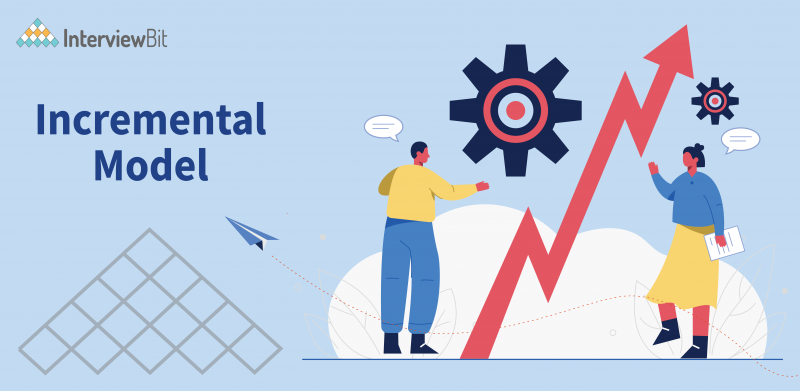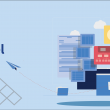In software engineering, software development lifecycle (SDLC) models are the process or methodologies that are elected for the development of the software product based on the project’s aims and goals. The developed model will describe how the software is to be developed for each iteration stage, as well as the processes to be followed for the actualization of these stages. There are a few factors to consider when choosing a model for developing software, including the organization’s nature, the impact on testing methodologies, and the objectives to be met. One such approach is incremental development.
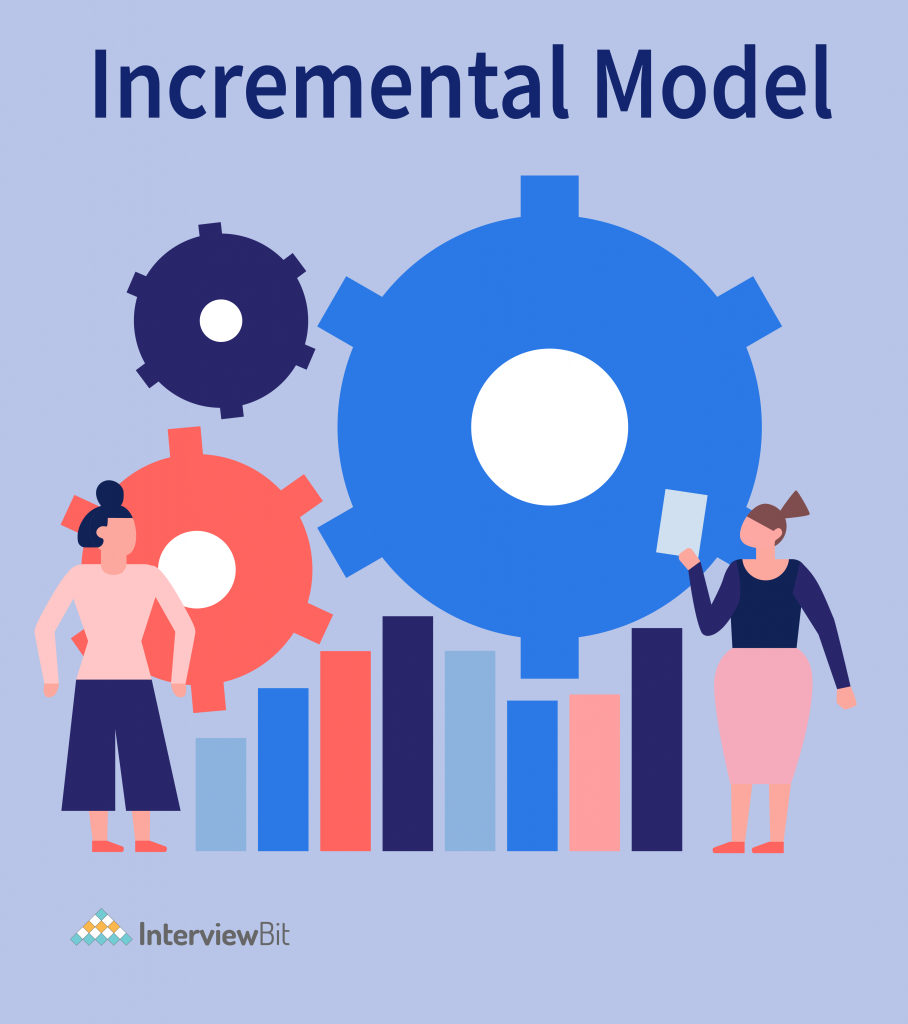
The software industry is in a frenzy over incremental development. It is the most widely adopted model of software development, in which the software requirement is broken down into multiple modules during the SDLC. All modules are treated as sub-projects that follow all phases of the SDLC incremental process.
In this article, we’ll look at 4 phases of the incremental model in software engineering that can help make the software development process more effective and lead to the development of higher-quality software. Before continuing, let’s first understand what the incremental model is all about, what are its types and when to use this approach.
Confused about your next job?
What is an Incremental Model?
Incremental Model, also known as the successive version model, is a widely adopted model of software development process where the software requirements are divided or broken down into multiple stand-alone modules/increments in the SDLC (Software Development Life Cycle). Each increment is treated as a sub-project and goes through all phases of the SDLC incremental model. This sounds similar to an iterative model. However, this model is an enhancement to the iterative model and due to this, the incremental model is also called the Iterative Enhancement Model. In the incremental model, instead of making one huge leap, we achieve our goals in small steps.
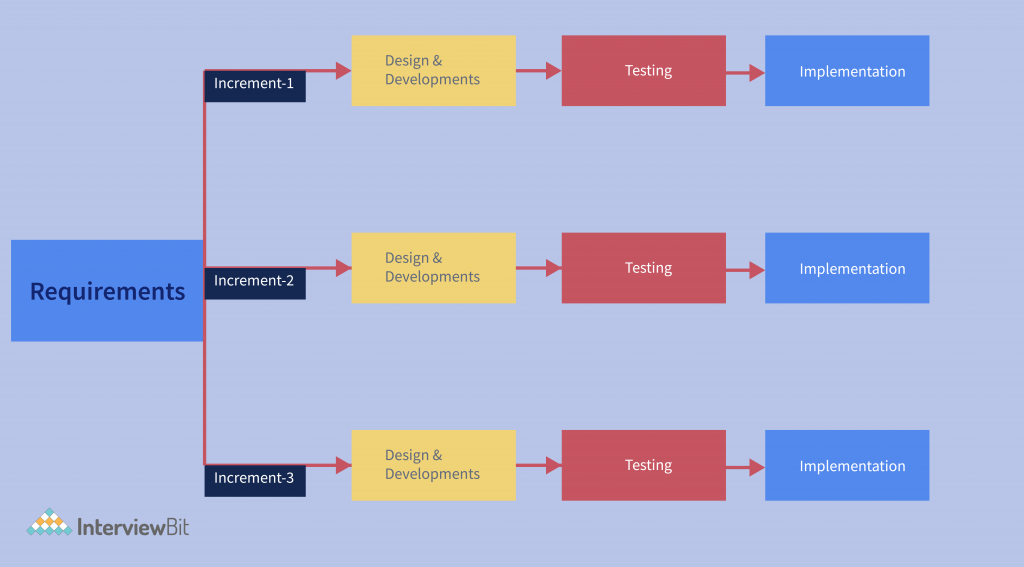
As soon as the requirements are divided into modules (increments), incremental development will begin as shown above. As part of the Incremental model, each module (increment) passes through four phases: requirements, design and development, testing, and implementation. Every new release of the module adds functionality to the previous release module. The process continues until all the intended functionality has been implemented and the complete system is developed.
Example: Here is an example to help you understand the incremental approach. Assume we are expected to deliver a word processor to the client by an impossible deadline. We will consider incremental development for this project. As part of the software development process, we have divided the software requirements into three specific modules A, B, and C as shown below. Each module of a Software Product is incrementally developed and delivered.
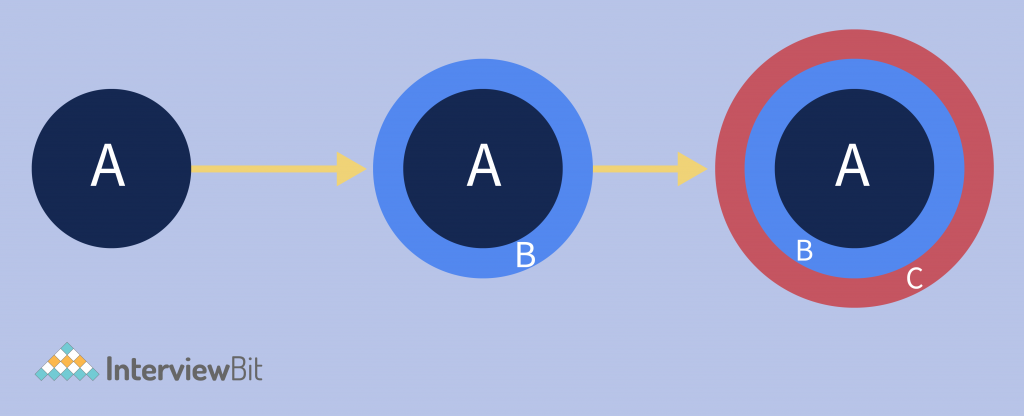
Accordingly, the first release (A) of the software contains file management, document generation, and editing capabilities. With the next release (B), sophisticated editing tools and advanced file creation functionality will be included. This further increment (C) will provide features such as spell checking, grammar checking, mailing, etc.
As a result, the incremental model releases the project part by part. Initially, the system is stripped down to a basic level (Increment A). The stripped-down version provides customers with the opportunity to evaluate the increment and suggest improvements that can be implemented in future increments.
Types of Incremental Model
In Software development life cycle models, there are two types of incremental models as follows:
Staged Delivery Model: This type of incremental model involves only one part of the project being built at a time. In the staged-delivery model, you do not deliver the software all at once, but rather in successive stages throughout the project as shown below.
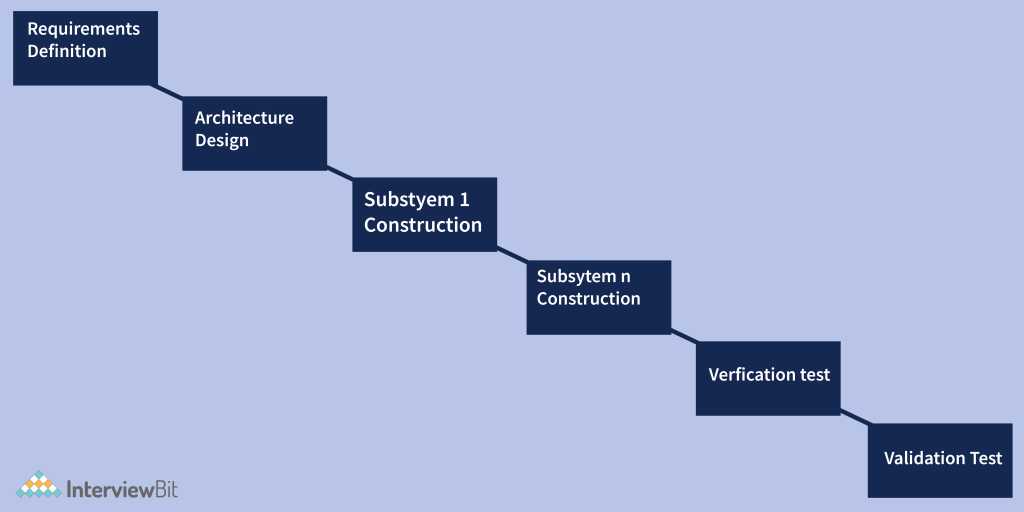
Parallel Development Model: This incremental model involves the simultaneous development of different sub-systems as shown below. As long as sufficient resources are available, it can decrease the amount of time needed for the development process, i.e., TTM (Time to Market).

When is an Incremental Model Used?
Most often, Incremental Models are used in the following scenarios:
- Requirements are clearly specified, understood and are known up-front. Certain requirements, however, require time.
- There is a requirement to release the product early or get it to the market early.
- Engineering team lacks the required skill set, or the resources are unavailable.
- Product-based companies develop their own products.
- New technologies are used.
- High risk goals or features are involved.
- Projects have long development schedules.
Now, what are the phases of the Incremental Model? Let’s take a look at the 4 Phases of an Incremental Model.
Phases of Incremental Model
In the following diagram, you will see the different phases of the SDLC incremental model. Check them out:
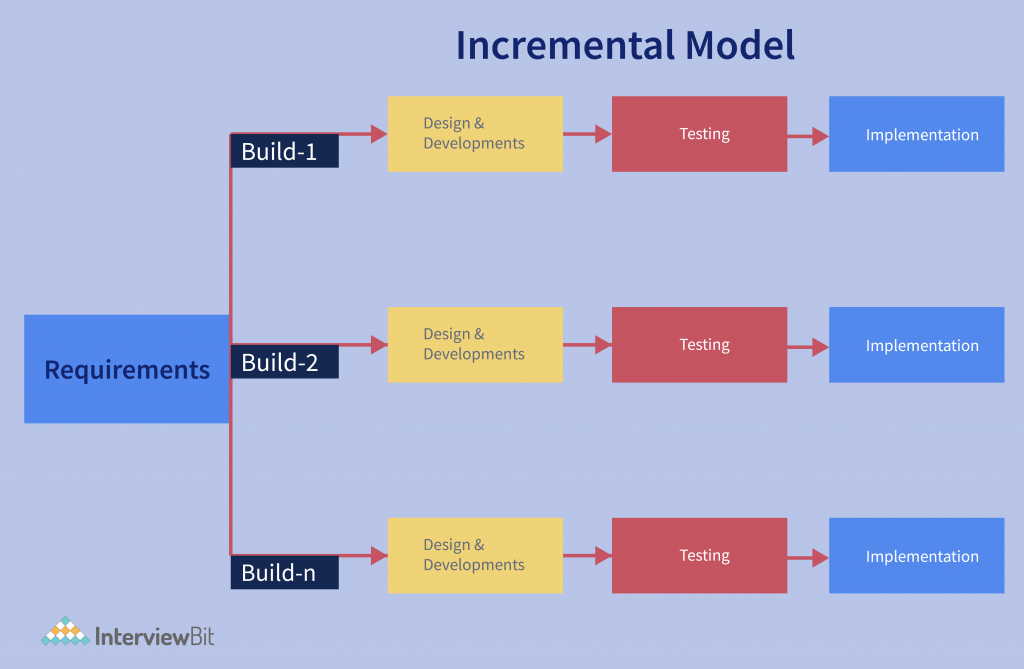
1. Requirement Phase
The incremental model in software engineering begins with the requirement phase. This phase is extremely important in product development because developing a solution that gives value to clients is impossible without understanding the initial requirements. At this stage, business analysts and project managers gather functional requirements as well as non-functional requirements from potential clients.
Having completed the requirement analysis process, the team should collect all of the project’s requirements in one document. After gathering requirements, the Business Analyst (BA) converts them into technical requirements with the help of senior team members such as the Subject Matter Expert (SME) and the team leader. A document called the SRS (Software Requirement Specification) contains detailed specifications of the technical requirements. After the SRS has been created, we need to send it to the client or to SMEs on the client’s side for approval before proceeding with the next phase. The SRS will be a reference document for the next phase.
2. Design and Development Phase
During this phase, the product architect develops an optimized product architecture by using the SRS document. The product architect creates a rough design, working models, specifies how the software works, how the new design looks, how the control flows from one screen to another, etc., based on the requirements provided by SRS. When they are done creating the product architecture, they will save it in a DDS (Design Document Specification). Diagrams like Entity-Relationship Diagrams (ERDs) and Data Flow Diagrams (DFDs) may be included in this document. Once approved by all stakeholders, the DDS document can be implemented. Eventually, overall system architecture is designed by defining each module’s functionality (capability) and its interaction with other modules or cross systems.
Next, developers begin development by following the coding standards established by the organization. Code is developed from scratch according to the requirements in SRS, as well as the design specifications in DDS. Developing clean and efficient code can have a significant impact on the performance of software, so programmers must write code in an organized and detailed manner. As well, the language used to write the software code can vary depending on the type of software being created, its objectives, and its environment of use. Upon completion of coding, developers use the programming tools to compile and debug the new code to ensure that it works properly.
3. Testing Phase
In this phase, once the code is written, it is tested to determine whether it works as expected. Prior to handing over code to the testing team, the developer performs initial testing such as unit testing and/or application integration testing. If all goes well, the code is moved to the testing environment.
From there, the testing team will perform the testing. There are several types of testing the testing team performs quality assurance (QA) testing, system integration testing (SIT), user acceptance testing (UAT), and approval testing. Testing is done to determine if the code and programming meet customer/business requirements. Before the implementation phase begins, companies can identify all bugs and errors in their software during the testing phase. Software bugs can jeopardize (put someone/something in a risky position) a client’s business if they aren’t fixed before deployment.
4. Implementation Phase
The incremental model of software development has reached its final phase. The product is ready to go-live after it has been tested and has passed each testing phase. The product is therefore ready to be used in a real-world environment by end users.
After the software is fully tested and is free of errors and defects, the client reviews the test results and approves the deployment. Upon product deployment, the new functionality becomes available to the current end-users of the system. In some cases, product deployment may be divided into several phases based on the company’s business strategy. A user acceptance test is one of the ways companies seek feedback from the intended users. Thus, the software can be tested in a pre-production environment, before a real-world production, thereby leading to better results.
Advantages and Disadvantages of the Incremental Model
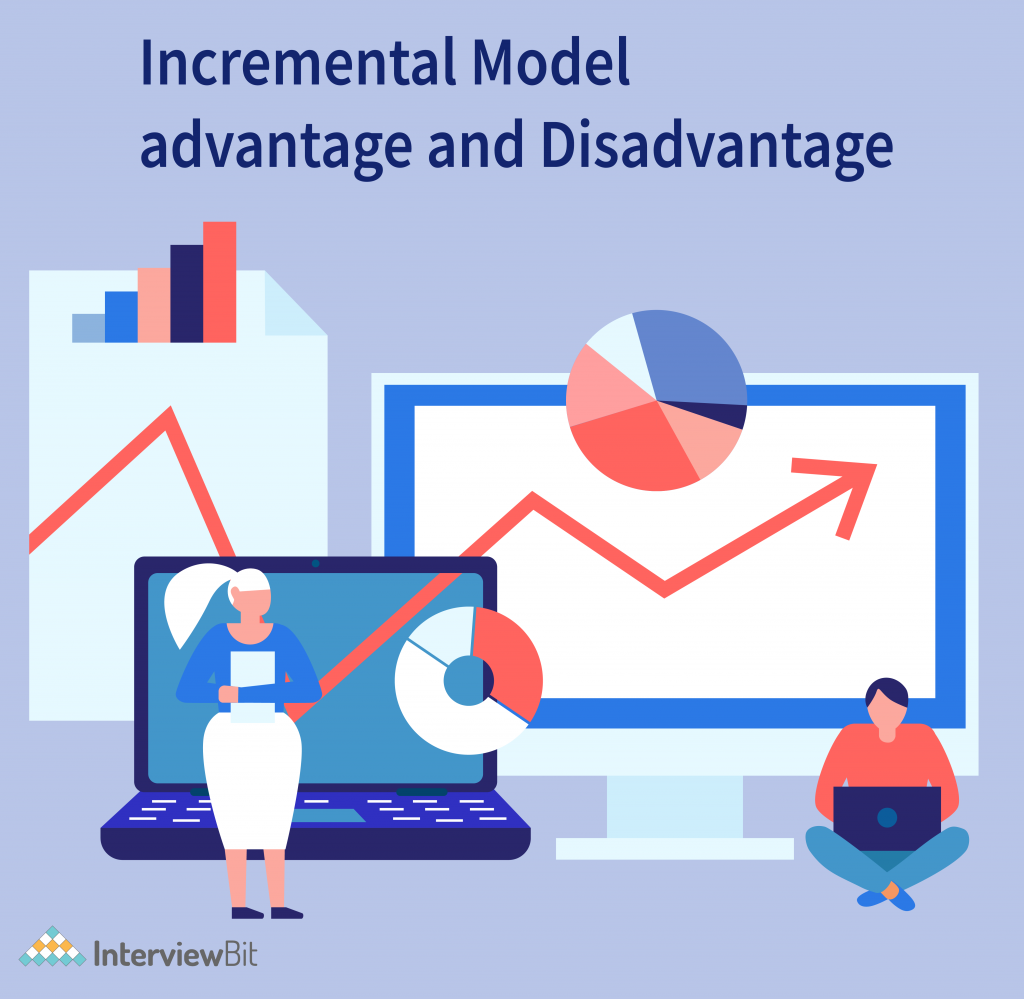
What is the Major Advantage of Using Incremental Model
Incremental models offer a number of benefits, some of which are highlighted below:
- Through incremental development, 100% of the software objectives and requirements are met.
- A good option for dealing with cost and flexibility is the incremental model. Scope and requirements can be altered at any time throughout development.
- Verifying and debugging this model is easy and straightforward.
- This model enables us to produce working software earlier and more rapidly during product development. As a result of dividing the work, completion time can be reduced.
- This model permits the client to respond to and provide feedback on every build.
- Identifying errors becomes easy with incremental models. This simplifies risk management since risky pieces are identified and dealt with during iterations.
- The product’s most important and useful functional capabilities can be identified at an early stage of the development process.
Disadvantages Of The Incremental Model
The incremental model also has disadvantages, some of which are listed below:
- This model requires meticulous planning and designing.
- In order to break it down and build it incrementally, it needs a complete and clear definition of the whole system.
- If the requirement is not comprehended at the beginning, the whole purpose of incrementing will be shattered. So, system architecture may encounter problems if not all requirements are collected up front during the entire software lifecycle.
- A problem in one unit needs to be corrected in all units, which takes a lot of time.
- The iteration phases are rigid and they don’t overlap each other.
Conclusion
Various models are available for developing software and meeting the desired objectives, but incremental modeling achieves 100% of expected software objectives. In the incremental model, instead of making one huge leap, we achieve our goals in small steps. This model is used when it is not possible to reach a decision in one go, but necessitates a step-by-step process. This model is primarily applied where we have a clear understanding of the requirements and when 100% accuracy of the software is required. The incremental model is most common in the public sector, where major changes would probably cause public conflict, and in software development, where small changes will help avoid costly errors.
In this article, we have covered what is an incremental model in software engineering, types of incremental model, when to use it, the different phases of an Incremental model, and its advantages and disadvantages. Hopefully, this article will provide you with insight into incremental model development and lead you to even greater success.
FAQs
Q: Where is the incremental model used?
Sol: It’s easier to test and debug incremental development since relatively fewer changes are made during each iteration. It is especially popular when we need to quickly develop a system with a limited set of functions. This method is more commonly used by web application developers and product companies.
Q: When to use the Incremental model?
Sol: Most often, Increment Models are used when:
- Requirements are clearly specified, understood, and are known up-front. Certain requirements, however, require time.
- There is a requirement to release the product early or get it to the market early.
- Engineering team lacks the required skill set, or the resources are unavailable.
- Product-based companies develop their own products.
- New technologies are used.
- High risk goals or features are involved.
- Projects have long development schedules.
Q: How is the incremental model different from the spiral?
Sol: With spiral models, iterative development models are combined with sequential linear development models (waterfall models) with a strong emphasis on risk analysis. While the incremental model is a way of developing software by analyzing, designing, testing, and implementing the product incrementally until it is finished.
Q: How is the incremental model different from the iterative model?
Sol: Incremental: It is a software development process where the software requirements are divided or broken down into multiple stand-alone modules/increments. Each increment is treated as a sub-project and goes through all phases of the SDLC incremental model.
Iterative: In an iterative model, software development activities are repeated in cycles known as iterations. Each iteration of the software produces a new version until the optimal product has been achieved.
Additional Resources
- Practice Coding
- Waterfall Model in Software Engineering
- Iterative Model in Software Engineering
- COCOMO Model in Software Engineering
- RAD Model in Software Engineering
- Spiral Model in Software Engineering
- Software Engineering MCQ
- Software Engineering Books
- Software Engineering Resume
- Software Engineering Projects
- Characteristics of Software
- Principles of Software Engineering


